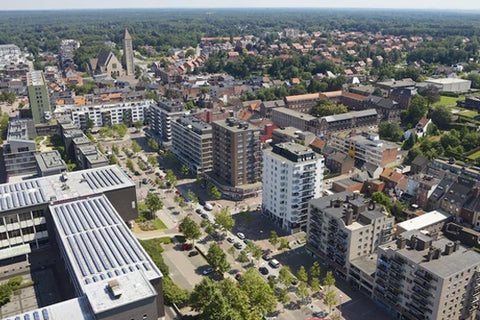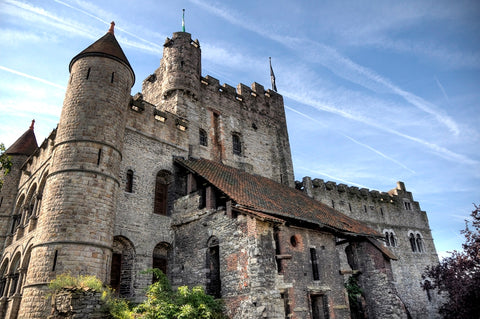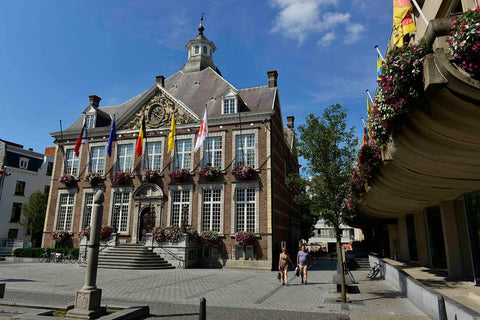- No products in the cart.
Bouillon

More castle, than town. More 'the great outdoors', than buzzing nightlife. Bouillon is a town that manages to nail the best bits of the Belgian Ardennes – even if it only just hangs onto that 'Belgian' tag. France is literally a stone's throw from this pretty little town, which is tucked up tight against the south-western Franco-Belgian border. It sits at the heart of a landscape that isn't often associated with Belgium – dark forests and ravines, steep hills and cliffs – all peppered with castles, abbeys and wild tales. The Ardennes reputation as an impenetrable wildland once kept visitors at bay. And Bouillon has played its role in that legend, home to a brooding castle that guards one of the few routes through the region – the meandering Semois river valley.
Not that it looks particularly ominous these days. The town has laid itself out very prettily beneath the castle, lounging along a wide bend in the Semois, with camp sites, an adventure activity centre, signed walks and cycle-tracks criss-crossing the surrounding woods. An historical town, fortunate enough to emerge relatively unscathed by both world wars, Bouillon has very French-vibe – all white-washed walls, shuttered windows and patisseries. It also has some excellent restaurants, two interesting museums and a very nice little brewery. Enough all-round prettiness, in fact, for it to become known as the Pearl of the Semois (and not just by the local tourist board).
But this town, whose skyline is so dominated by a large pile of defensive masonry, can't have had such a pretty history? Surely a peek at the history books would show that Bouillon has walked on the wild side of the Ardennes, over the long centuries since it was built? Well, the truth-be-told, its history has had more to do with far-off crusades and mortgages, than battles and home-town sieges.
History
Julius Ceasar called the Ardennes 'the greatest forest in all of Gaul', and he had a hard time conquering the Gallic tribes living in the area. It's almost certain that a fort of sorts was located around Bouillon in those times (the name appears to be from Gallo-Roman times), but the first recorded mention of Bouillon's castle was in 988. A letter from Adalberon, Archbishop of Reims to his brother Godfrey the Captive noted the castle as part of their property – they were both from the House of Ardenne.
But it was another Godfrey, the fifth in line, who lost the illustrious Duchy of the Ardenne this important fortress, when he mortgaged it in 1096. That was so he could go off-crusading. Not just any crusade either – it was the First. And not just any Godfrey. This was the Godfrey of Bouillon, a duke who went on the become conqueror – and first Crusader ruler – of the Kingdom of Jerusalem in 1099.
Godfrey of Bouillon, the not-quite-King of Jerusalem
The call from Pope Urban II for a crusade to liberate Jerusalem fell on rather receptive ears with Godfrey. He sold many of his lands, and put others, including the Château de Bouillon, down as collateral, so he could raise an army. His band of 40,000 was one of the four biggest armies to head off to the Holy Land as part of that First Crusade. Along the way they got tangled up in a few battles on behalf of the Byzantine empire. But it was in Jerusalem that Godfrey's legend was forged.
He was one of the most eager to take the Crusader armies to Jerusalem, which they reached in 1099. And he was at the head of the army that successfully crested the walls of Jerusalem, and vanquished its Fatimid rulers. But rather than accept the crown as the new 'King of Jerusalem' – a title he thought only fitting for Jesus himself – he accepted himself as defender of the Holy Sepulchre. His triumph and humility was short-lived, however. He died less than a year later, a few months after becoming ill, in 1100.
But that moment of glory was enough to earn him a place in the history books. And a rather satisfactory 17th ranking in the Belgian public's affections, according to a recent vote on Belgium's national heroes.
His death, however, did leave the Bouillon castle in the hands of the 'bank' – in this case, a certain Otbert, the Prince-Bishop of Liege who had advanced the loan. The Prince-Bishops of Liege held onto the castle for much of the next 600 years, although along the way the wily La Marck family managed to wheedle their way into becoming dukes of the Duchy of Bouillon (without actually owning the castle). Then, in 1678, the French walked in, and promptly handed the castle over to another well-connected family – the La Tour d'Auvergne's. It was fitted out with heavy artillery by the famous French military architect Vauban, and became known as "the key to the Ardennes", under the 'protection' of the French.
It then became part of the Kingdom of Holland – briefly, after the French lost at Waterloo – before finally becoming part of Belgium after the 1839 revolution against Dutch rule. That uprising left the big powers in a quandary over what to do with the Duchy of Luxembourg, which then included Bouillon. In the end, the eastern half became part of the new Luxembourg nation, while western half – with Bouillon inside – was given over to the Belgians.
War did finally come calling, however, in the 20th century. The area around Bouillon became the scene of two dramatic thrusts by the Germans, either side of the six long years of the Second World War. The first, in 1940, had the panzers thundering through Bouillon, on their way to victory over France. But the combat was mercifully limited. The second saw the return of the panzers, as they took part in the 1944 Battle of the Bulge – aiming to thrust to the North Sea, and so prevent Germany's imminent defeat. Fortune smiled on Bouillon, however, and the Germans never made it as far as this pretty town.
So the magnificent and complex fortifications of Bouillon remained intact – ready to be swamped by new invaders (global tourists), having successfully dodged history's cannon ball.
Getting There & Getting About
Sitting down in the darkest, deepest Ardennes, Bouillon isn't quite as simple to reach as most of Belgium's tourist hotspots. But when travelling through this forested hinterland, the journey can be as rewarding as the arrival, and so well-worth the extra effort. Public transport isn't great here, but it can be done. The nearest train station is Libramont, 30 miles east, which can be reached from Brussels by taking the Brussels-Namur-Luxembourg line. There is a semi-regular bus-service from Libramont to Bouillon, with half-a-dozen buses per day, taking you close to an hour to reach the town.
By car, if you're coming through Belgium, take the E411/A4 from Brussels, and keep heading south to Namur and beyond. When you reach the exit for the E46/N89 – about a 100-mile drive – take it, and head back west. This road becomes the N845, which takes you through wooded hills to Bouillon. You can also come in from French side, by heading for Sedan, and then heading east along the E46/N58 and crossing the border.
One word of warning. For the Belgians, an 's' makes all the difference between one country and another. Signs in Belgium that are inscribed with 'Ardenne' refer to the Belgian region, whereas those with 'Ardennes' are on the French-side. The French generally don't make the distinction in the same way. Confused? You will be..
Accommodation
Bouillon might be a small town, but it is packed with some wonderful hotels – tourists are the lifeblood for the town, after all. There's the Hotel de la Poste in the centre of town, a 300-year old building right next to the Semois, which counts Napoleon III and Emile Zola among its distinguished visitors. Closer to the castle is the La Porte De France, which is right beneath the fortress, and is in fact sited in its old watermill. There are plenty of other hotels and guest-houses in town, but with a landscape this dramatic, many choose look further afield.
There are some splendid luxury hotels tucked further into the woods, like the Aux Roche Fleuries, on the Les Crêtes peninsular in the nearby hamlet of Frahan. But the area around Bouillon is particularly big on self-catering and self-sufficiency, when it comes to accommodation. 'Gites for hire' are thick on the ground here – just check out those registered with the official gites bodies, Accueil Champêtre en Wallonie or Gîtes de Wallonie.
And naturally enough, a canvas roof is popular for a province so well-suited to walking, biking and general outdoor adventuring – so Bouillon has plenty of camp-sites. They range from cosy and well-furnished, close to the town itself, to some more basic but unspoilt pitches found in the surrounding woods and hills.
For The Love Of Beer
Bouillon could be said to be at the heart of Trappist country, lying at the centre of triangle drawn between the holy trinity of Chimay, Rochefort and Orval. So it makes a great base for the beer-tourist to launch him-(or her-)self out from, for some fabulous tasting and name-dropping forays. But the closest of these three, the Abbaye Notre-Dame d’Orval, is still some twenty miles off. Close, but not exactly sniffing distance. So let's keep it local, and look at what the town itself has to offer to the beer-lover. And like many place in Belgium, things here have changed a lot in the last 20 years.
The general Belgium beer renaissance of the last decade or so has been something of a voyage of self-discovery for the average Belgian. They always knew their beer was good, but it took the rest of the world telling them just how good, to fuel the explosion of local and micro-breweries in their towns and cities. The Brasserie de Bouillon is a case in point.
It was started only in the mid-1990's, following a successful branch into beer-brewing by a couple running a local produce shop – Nathalie and Jacques Pougin. They started by stocking an ever-expanding range of the local bottled beers, before brewing their own – the (initially) one-off Cuvée de Bouillon. It was such a success that the couple decided to go full-time, and started the Brasserie de Bouillon, so ending the century-long hiatus in the town's brewing tradition.
The brewery now has four regular 'craft' beers on its book, each with its own imaginative twist to the traditional Belgian beer-making craft. The original Cuvée de Bouillon is a rather strong (6.5% ABV) lager that is unfiltered and bottle-fermented. It might look like a blonde, but it is infused with the classic spices of a white – lemon, coriander and orange. The Medieval Amber is darker malt beer (6% ABV), tinted-copper with a no-nonsense mild and malty palate, and only a hint of bitterness.
The Bouillonnaise Brown (7% ABV), like the others unfiltered and bottle-fermented, takes the malt notes further, to give a dark ale that is both sweet and sour (and just slightly fruity). And 'fruity' also extends to the label, which features brown-haired beauty in skimpily bad-taste. Finally the Brasserie de Bouillon have tried their hands at a witbier with a difference – their Blanche de Bouillon is a more fulsome white than usual, spicier, sourer, and a tad more alcoholic (at 5.5% ABV). A great refreshing summer-time brew.
Food & Gastronomy
As a town lying in a region swarming with boar and deer, criss-crossed by rivers teeming with fish, and stippled with small farms where the pig is king, it's no surprise that Bouillon's food is heavy on the meat (and low on the salad). The local restaurants also like to go large on the courses, so you'll find a host of imaginative takes on Ardennes staples folded into each meal. Jambon d'Ardenne is a must-do, a slow-burn juniper-smoked ham that defines the taste of the Ardennes. Ardenne pâté is made from the more feral of the local porcines – the wild boar roaming the forests. You'll also see plenty of pheasant, venison and hare on the menu.
As well as the 'fruits' of the wood, the 'fruits' of the river are invariably on the plate somewhere. Sander, crayfish, pike and shrimp all feature, but trout is probably the most-important dish locally. Fished fresh out of the pristine waters of the river Sembois, Bouillon has a 'Trout Festival' to celebrate its premier piscine-cuisine. The town's restaurants compete to offer imaginative trout-based dishes, including truite aux amandes (trout with almonds), truite la manière Normandie (with potato and cider) and of course truite Ardenne (with mushrooms, shallots and red wine).
It's not all meat and fish though – the forests are home some great picking grounds for edible wild mushrooms, beechnuts, walnuts and wild berries – like the redcurrants that find their way into many-a-course. The town itself has several restaurants of note. La Vieille Ardenne on the main street is great for traditional local dishes, while Le Baratin does an excellent job of covering Belgian staples like moules-frites, Flemish stew, and waffles, in addition to the Ardennes specialities. A really interesting dish, brouet de boeuf la cardamone, is served up by the Hotel Restaurant Cosy. This cardamon flavoured beef-dish is allegedly inspired by the spices returned from local lad Godfrey of Bouillon's crusade.
Sightseeing & Culture
Sightseeing starts and ends with the castle – literally. It's the first thing you'll see on the way in, and the last on the way back out. And a wander up to, around these medieval fortifications doesn't disappoint on all of that visual grand-standing.The Château de Bouillon lives up to everything you'd expect from an ancient citadel. The castle rises, tier upon tier, wall upon wall, tower on tower, right the top of the narrow ridge nipped between the meandering Sembois river.
As well as some superb views from the vantage point of the 16th century Tour d’Autriche, a tour of the castle will take you down – through the tunnels, dungeons and torture chamber lying underneath (including the 200-foot drop of the castle's well). There's plenty to occupy kids too, with organized story-telling and treasure hunt sessions (though you'll need to pre-book these). The castle is also home to an impressive display of falconry, with a two-hour show involving eagles, buzzards, owls and (of course) falcons doing their diving and swooping thing.
Away from Bouillon's central attraction there's plenty more historical action to be had. The town has two museums, with one – Musee Ducal – covering the history from the iron age onwards, while focussing on the fascinating religious art of the region. The other – the Archéoscope Godefroid de Bouillon – tries to bring to life the times of Bouillon's most famous son, Godfrey, on his First Crusade. The idea is to use audio-visuals, special effects and music to immerse you in the long journey of that Crusade, and its ultimately successful conclusion in Jerusalem.
Activities & Entertainment
Bouillon is the sort of town that has 'active' written all over it. Tourists flock here as much for adventure, exercise or rural bliss, as they do for admiring its medieval glory. So the town has set itself up well to cater for the more active of visitors, with the surrounding forests opened up to walkers, cyclists and hikers by well-marked routes and trails. Mountain bikes were just made to be thrown around this kind of terrain, and there are several purpose-built tracks for those looking for a two-wheeled challenge.
Talking of adventure, there is a well-equipped outdoor centre at Semois Adventures, which covers a whole slew of adrenaline-boosting activities – zip-lining, rappelling, kayaking, orienteering, archery and raft building, to name a few. It's especially welcoming to children,and hosts many group and team-building activities. If you're particularly professional in your approach to adrenaline-seeking, there are several cliffs and ridges in the area, which offer some suitably-challenging rock climbing routes. And if you want a more gentle introduction to the great outdoors, kayaks can be hired from several locations, both in-town, and further along the Semois valley.
But if you want to take it really tame, try the 'Parc Animalier' just outside Bouillon. This zoo-cum-farm over 60 species of animals (some tamer than others), along a mile's pleasant stroll. There's also a large playground, so this is a great one for distracting the kids.
B2B & Conferencing
It may not seem the most obvious place to do business, but Bouillon has a lot to offer those looking for something 'out of the ordinary', when it comes to meetings, incentives and conferences. The setting pretty much defines 'relaxed' and 'stressed-free' – not qualities the typical urban meeting place can boast of. There are also plenty of unique and characterful venues, especially for organizers of small and medium meets or events, to choose from – both in town and out in the sticks.
And Bouillon has everything you'll need for an incident-rich team-building exercise, or a rewarding incentives program. Mountain-biking, hiking, orienteering rock climbing, rafting – the possibilities are endless. And at the end of the day, the local cuisine and the renowned Ardennes hospitality offers plenty scope for relaxation and recuperation too.
The local Bouillon MICE (Meetings, Incentives, Conventions, Events) office is especially focussed on helping businesses to develop their convention, meeting and exhibition ideas in the west Ardennes. It can advise on the logistical side of organizing meetings and conventions, and suggest the best venues and locations. MICE Bouillon will even help with enquires on the availability of venues, and can help get discounts and special offers from hotels, convention and exhibition centres, and group-booked restaurants.





